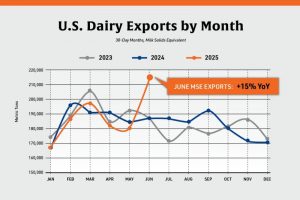
A panel discussed opportunities and challenges at World Dairy Expo.
On Oct. 4, the last day of the 2024 World Dairy Expo in Madison, Wis., dairy leaders held a discussion about the future of the U.S dairy industry during the Global Dairy Summit, sponsored by the Wisconsin Department of Agriculture, Trade and Consumer Protection.
Wisconsin Ag Secretary Randy Romanski introduced the panel members:
-
moderator Corey Geiger, lead dairy economist, CoBank
Heather Anfang, dairy foods president and executive vice president, Land O’Lakes Inc.
Krysta Harden, president and CEO, U.S. Dairy Export Council
Mike McCully, president and owner, McCully Consulting
David Lenzmeier, CEO, Milk Specialties Global
Consumers prefer real dairy
Last year, more than 92% of U.S. households purchased real dairy products. When comparing retail purchases of dairy to plant-based alternatives, real dairy sales were 21 times larger.
“Plant-based volumes are declining,” Anfang said. “Ninety-seven percent of U.S. households buy cheese, 93% buy butter, and 92% buy milk.” Anfang noted that each household spends an average of $670 per year on real dairy products.
While families and individuals do eat at restaurants and order takeout food, 86% of eating occasions were sourced from home over the past year, Anfang said.
“U.S. consumers eat an average of 42 pounds of cheese per year,” she said. “Global cheese consumption is expected to reach a record high this year.”
Anfang said Land O’Lakes, headquartered in Minnesota, processes 12 billion pounds of milk per year from 1,000 dairy farm members. It also has 9,000 employees.
Demand for butter remains strong as well, she said, adding, “Consumers eat more butter every year.”
Land O’Lakes is finding simple ways to meet consumers’ dairy needs, Anfang said. In the past year, they have begun marketing butter balls — 1.5-teaspoon balls of cold butter in a package that are popular with millennials.
“You don’t have to cut the butter or touch it,” she explained. “You just throw a few butter balls into a pan.”
Other new dairy products that Land O’ Lakes has developed include dairy case cheese and flavored seasonal butter spreads.
Anfang said 9 out of 10 consumers say sustainability is very important to them.
“Seventy-five percent of millennials say they consider sustainability when they make a purchase,” Anfang explained. “Twenty-five years ago, nobody was asking where their food was coming from. Today, they want to know. Dairy has a great story to tell, and we need to keep telling it.”
Dairy exports on the rise
Harden said dairy exports have become a critical part of dairy demand. Seventeen percent of U.S. milk production is exported.
“Since 2019, 24% of new cheese production in the U.S. was exported,” Harden said. Rising global demand for U.S. dairy products has boosted producer margins markedly.
“Dairy exports are increasing global demand for dairy protein,” she noted. “U.S. farmers have increased milk production, which means we are primed to meet the dairy protein needs of the global consumer. Our competitors — the European Union, Australia and New Zealand — do not have the capacity to supply the growing demand. We have very efficient and successful dairy farmers to meet the needs of dairy demand throughout the world.”
New milk plants being built
McCully said several new dairy processing plants are being built throughout the U.S. Several states have seen dramatic increases in milk plant processing capacity between 2014 and 2023 (see table below).

“There is a historic amount of new investment in milk processing in the U.S. creating an environment where milk plants are chasing milk,” McCully said.
Domestic demand trends look positive with solid growth prospects for dairy products — mostly for cheese, whey and extended shelf-life milk.
“Milk will shift between plants and products with implications to availability, price and plant viability,” McCully said. “For companies that won’t invest, things are not so bright.”
Over the next few years, McCully said more than $7 billion in new investments will be made in new processing plants in the U.S. These new plants mean the U.S. will need between 50 million and 60 million more pounds of milk per day. McCully broke down the per-day milk increase needed by region:
-
Midwest. 12 million to 15 million pounds
-
Northwest. 8 million to 10 million pounds
-
Southern Plains. 20 million pounds
-
West. 8 million pounds
“New plants will get the milk, but will take it from existing processing plants,” he explained. “Milk powder plants are likely to be the most impacted as milk shifts to new plants for cheese, butter and extended shelf-life milk. Some plants will have to change their product mix or potentially close.”
Leader in nutrition, animal health
Lenzmeier said his company, Milk Specialties Global, has 1,400 employees and has been the industry leader for 75 years in manufacturing milk replacer for calves. Milk Specialties Global also partners with 13 companies to make sports drinks.
“Our focus is on nutrition and animal health,” Lenzmeier said.
He noted that Milk Specialties Global, which is headquartered in Eden Prairie, Minn., is a major exporter of U.S. dairy products. “About 25% of our company’s sales are international,” he said.
Ahora puedes leer las #noticias más importantes en los canales de #Whatsapp de #eDairyNews!!
🇲🇽 eDairy News MÉXICO: https://whatsapp.com/channel/0029VaLDr0G4SpkLXxDY3t2x























